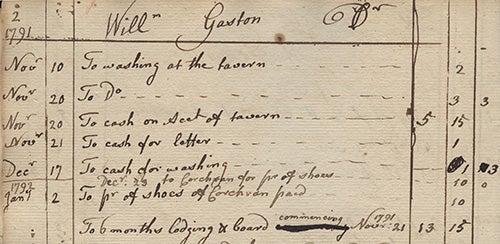I am sometimes asked how archivists decide which materials to add to their collections and which materials to decline. My accurate but somewhat unwieldy explanation is that archivists consider records to be worthy of addition if they have a permanent value, and that this value is typically defined in terms of a research, historical, legal, financial and/or administrative value. And that for a university archives specifically there is an additional value to be considered—an emotional or nostalgic value attached to records with the potential to connect Georgetown alums to their part in the continuum of the University’s rich heritage. To further complicate the explanation, it is necessary to add that different values can attach to the same record over time.
Recently, I was looking at the financial accounts of our first student William Gaston, which are among the earliest records in the Georgetown University Archives. I realized that they are an almost perfect vehicle for illustrating the concept of archival values and how they can shift over time.
Billy Gaston traveled to Georgetown at the age of 13 from New Bern, North Carolina. His father, a doctor, was killed during the Revolution, so arrangements for his education fell to his mother. He first arrived in spring 1791. Georgetown was not yet open for students, so he went on to Philadelphia. When he returned in November, the only building on campus was still not ready for habitation and he moved into a nearby inn for almost two months. This is reflected in the opening entry of his account: November 10, 1791: To washing at tavern 2 [shillings]. Gaston’s account, like all our early accounts, is kept in pounds sterling and so three columns are needed, for pounds, shillings, and pence.
I think everyone would agree that Gaston’s financial accounts belong in the University Archives, but by looking at the values listed in the first paragraph, we can link this instinct to archival theory.
When created, the accounts had administrative value as they documented whether Gaston’s mother had paid his fees in full. And they carried legal or at least quasi legal/fiduciary value. Georgetown’s early students were not allowed to have any money in their possession; the University held it for them. As a result, the financial accounts had to record every debit or credit, however small.
However, with the passage of time, the values attached to the accounts change. They acquire research value, given the insights they provide about Gaston’s student days and about the operation of the fledgling Georgetown College. Similarly, they acquire historic value by virtue of their being a record of Georgetown’s first student; as such, I frequently incorporate images of them into presentations to alumni groups, etc. They certainly have a financial value as an 18th-century document, although I am not precisely sure how to calculate that value. Like many items in the archives, the accounts are unique and we cannot buy replacements for them. For this reason, the insurance value of our items is calculated as the cost of salvage if they were to be damaged. And finally, had Gaston seen these accounts on one of his post-graduation visits, (he was elected to Congress in 1813 and frequently visited the College while serving in the body), they presumably would have had an emotional impact as a reminder of his time as a student on the hilltop.
These kinds of multiple and shifting values for one record over time are why archival selection is one of the most complex and challenging activities that any archivist undertakes.

